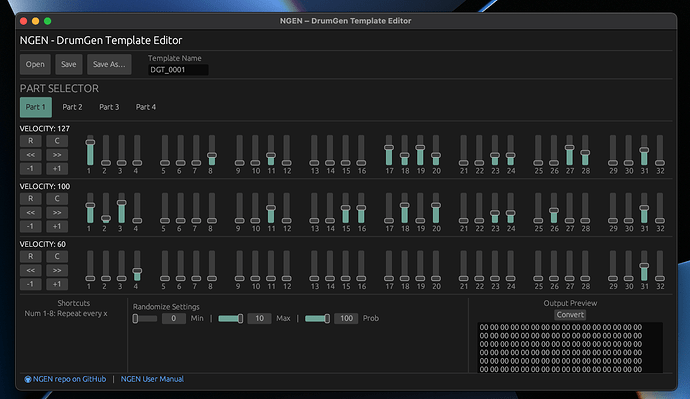Hi everybody!
Today we’ve released a new open-source GUI editor for creating and editing DrumGen templates for NGEN.
About the DrumGen Template Editor
The editor is written in Rust + eGui and it it’s capable of creating new templates from scratch or loading existing .hex templates.
It also includes some extra features like randomization, sequence shifting and more.
The editor is open-source and we’re open to suggestions and contributions!
Instructions
Compiled binaries will be available soon (still need to set up GitHub actions) but, in the meantime, you can find instructions on the repository on how to clone the repository and compile it on your computer.
You may need to install Rust on your computer first but the process should be easy for people with programming experience.
Feel free to send your questions and feedback about the new editor in this thread.
Hey 
I gave it a try and have a few feedbacks:
- There is a minor typo in install instructions
- Could be useful to implement undo/redo keyboard shortcuts
- Could be useful to add existing .hex files to git repo, for user to load as example (the ones that ship with NGEN)
Other than that, I believe it would be helpful to add a few lines in README to describe how it’s designed, what’s the philosophy behind it.
For instance - from what I gathered:
- Each
part represents 1 of 4 notes played by DrumGen generator
- Each line of 32 faders represents the steps (max sequence length being 32 steps for each note)
- For each step, a fader indicates the propability for a note to be generated on that step
But I don’t understand why there are 3 lines of 32 steps ? The ones labelled VELOCITY: 127, VELOCITY: 100 and VELOCITY: 60.
Does it mean user should use a fader of the right line to specify the velocity with which the generated note will play ? If so, what happens in case the same step is programmed to play with the 3 different velocities ? Like so:
As design goes, I think it would make things more intuitive if each step had a fader for velocity, in addition of existing fader for probability. Thus no need for 3 lines of 32 steps, but a single one. Thus all the handy buttons (Random, Clear, <<, >>, +1, -1) could be also added for velocity faders.
If the issue is that velocity cannot be anything else than the values 127, 100, 60; then it’s only a matter of widget: I suggest using vertical radio buttons
Otherwise, the editor runs well, good job ! 

